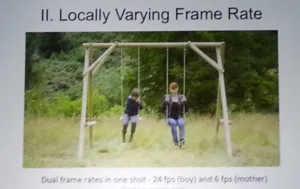Each year, SMPTE produces the NAB pre-show called the Technology Summit on Cinema (TSC), which I find a very worthwhile event to attend – if you have an interest in cutting edge technology as applied to the art and science of making movies.

We have full coverage of TSC and NAB in our special show report (subscription needed), to be published soon, but below is my personal highlight reel, in no particular order. (We have included links to the detailed articles, but the content is for subscribers to our Large Display Monitor newsletter.)
RealD used the Technology Summit on Cinema to provide an update on development of its Ultrascreen technology, which also included the first public demo of its new screen technology showing 4K content from an RGB laser projector. The company was careful to note that this is still an “alpha” product, which means manufacturing methods must still be validated. But it was still good enough to produce great images and help RealD garner some feedback on the technology. Advantages include higher efficiency, wider viewing angles, terrific stereo contrast and the ability to fabricate micro perforations for through-the-screen sound. This could really help improve 3D screening experiences and could be wildly popular in Europe where silver screens are not desired. (Screen Technology Gets More Attention.)
The screen was lit up with Barco’s RGB laser cinema projector, which has a redesigned and improved cooling solution and showed stunning 3D content.
RGB laser projector makers got a kick in the teeth recently when the FDA decided not to follow the European lead of treating the lasers in a cinema projector like a Xenon light source in terms of safety. New guidelines don’t go far enough so the industry will have to think about next steps.
The Pickfair Institute is dedicated to understanding the science and art of frame rates in movie making, focusing on what founder Jonathan Erland calls “creative frame rate”. He showed a number of ways to process content capture at continuous 240 fps captured content (360 degree shutter angle) to produce a variety of results at different frame rates and shutter angles – even frame rates and shutter angles that can vary within a scene for artistic purposes. James Cameron intends to use variable frame rates on the next two Avatar movies, while Doug Trumbull is going to be doing something similar with his solution, so Erland wants to be part of this discovering the potential of this new creative tool as well. (The Pickfair Institute to Focus on Frame Rate Technology and Creativity in Cinema.)
Immersive sound may not always get the attention of the advancement in the visual aspects of movie making, but it is just as essential. Now DTS has thrown its hat in the cinema ring with an immersive sound program based on it MDA platform. But competition from Dolby’s Atmos and Barco Auro3D has the industry worried about a format war. SMPTE is trying to address this with a standardization effort, but Dolby surprised the committees just prior to TSC by offering to open up its proprietary Atmos bitstream to become the standard. As a result, the industry may well make this the de facto standard. We will see. (Immersive Sound Options Grow with DTS Entry – Standards Remain an Issue.)
There was also much discussion about the BT2020 color gamut. The specification as written puts the RGB primaries on the spectral locus with a single wavelength and no tolerance. To achieve this requires lasers that operate at those wavelengths. But if you do this, you are liable to get high speckle and metameric problems. Metameric failure occurs with very narrow primaries where two people can perceive a color quite differently – something that does not usually happen with broader primaries. A debate is raging about redefining these primaries to reduce metamerism and speckle while recognizing the availability of commercial laser sources to meet the current or an amended 2020 spec. (Are More or Smarter Primaries the Solution to Metameric Failure in Laser Projectors?)
RealD’s Pete Lude also made an argument that exhibitors need to look a lot more carefully at the ambient light sources in their supposedly dark theaters. These sources, like an exit sign, have a profound impact on reducing total theater contrast. He also noted that high dynamic range projectors with a million to one contrast ratio will have a total theater contrast that is no better than one with 100,000:1. (Archiving and Light Levels Top IMAX Concern List.)
Discussions of virtual reality were prevalent as well with Jaunt CTO, Arthur van Hoff, describing how its 360-degree camera is being used for “cinematic VR capture”, while Barco and others described how their new three-screen Escape theatrical format is a step in the VR direction as well. This is a very hot topic right now as it is another story telling technique that has all kinds of possibilities that we are just starting to explore. (Barco Describes Continuing Evolution of Escape Theatrical Format.)
Disney Research described a short film it made to develop some very interesting technologies. I found the “per pixel flow-of-time” technology particularly compelling. This allows for global and local (within the frame) frame rate variations; slow motion and retiming, artistic shutters (effects) such as a rainbow, motion strobe and motion/smoke effects, and compositing/temporal alignment. In addition, the company was also able to demonstrate the use of high dynamic range tone mapping. (Disney Research Adds Attributes to Each Pixel.)
Fraunhofer has been developing a light field capture system for a few years and at TSC described a small film production that was undertaken to showcase the techniques and its capabilities. This is another powerful capture tool that opens up Pandora’s box to a range of creative possibilities that is sure to get film makers and others excited. (We interviewed the Fraunhofer about this at IBC – no subscription needed – Fraunhofer Explains its Virtual Camera Technology at IBC 2014.)
SMPTE is celebrating its 100 year anniversary in 2016 and is in the process of making a movie to commemorate that. A short clip was shown to get the faithful jazzed. It also rolled out a new campaign to get people to think about how large an impact SMPTE has had on our lives. Called “Life without SMPTE,” a short film shows how all the images and sound might not be here except for SMPTE. One perhaps unintended consequence of the campaign was the Facebook reactions where people “Liked” the idea of life without SMPTE.
Finally, thanks to Dolby, we now also have a formula for Creative Intent that describes the colorist’s ability to produce the desired visual effect. If the difference between what is desired and what is produced (DeltaColorVolumne) is zero, you have an infinite creative intent and all is well. In reality it is less than this and can be affected by the mix of science and art in the process. If alpha is zero (no science), then you need a lot of art to achieve the creative intent. This formula elicited a lot of smiles and chuckles, as you might expect.

There is much more in our detailed coverage. – Chris Chinnock

